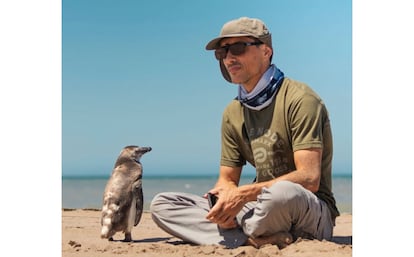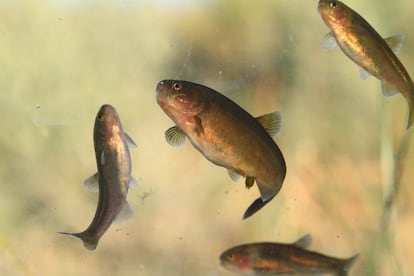The Argentine who conserves an ecosystem by saving a Patagonian frog

EL PAÍS offers the América Futura section for free for its daily and global coverage of sustainable development. If you'd like to support our journalism, subscribe here .
He came to the Somuncurá Plateau in Argentine Patagonia , motivated by a frog. More than 14 years ago, when he was finishing his PhD in Natural Sciences, biologist Federico Kacoliris (47, Buenos Aires) began studying the country's most endangered species. "I wanted to put together a conservation project with amphibians because I'm a herpetologist," he says. That's how he learned that, in that steppe, along the Valcheta stream, lived a frog that bears the same name as the waters in which it swims ( Pleurodema somuncurense ).
It is a unique species, known as microendemic. Although the stream is about 80 kilometers long, the Valcheta frog only moves along the first ten kilometers, where the waters are thermal and don't drop to temperatures as drastic as those in the rest of Patagonia. Having adapted to such specific conditions and facing various threats, its population plummeted. So much so that Kacoliris and his team estimate it has declined by up to 90% since it was first identified in 1968.
There wasn't much reason to hesitate. After visiting the area, the biologist launched a program to protect it, which led to his recognition with the Whitley Conservation Award , granted by the Whitley Fund for Nature. It's an exhaustive mission. First, the professor at the National University of La Plata recalls, it began with the classics. They restored the habitat and promoted the repopulation of the froglets by releasing bred individuals into the stream. They also controlled rainbow trout , an invasive species introduced around 1920 for sport fishing, which not only eats the frog's eggs and tadpoles but also affects the naked mojarra ( Gymnocharacinus bergii).

"Although I got there because of the frog, due to its urgent situation, what was happening with the mojarra was similar," he says. And every action they proposed to conserve the former had a positive impact on both the latter and the entire ecosystem.
But over time, the team noticed another problem. People living in the area reported frequent attacks on their sheep by pumas and foxes. Their instinct was to trade them for cows. "This type of livestock is less sustainable for Patagonia's environment ," Kacoliris explains. So a second phase of the project began, involving the local community. With some, they made agreements to fence the headwaters of the stream on private properties to prevent cows from approaching to drink. In return, they installed drinking fountains. Others, through the Somuncurá Foundation, which was also created, were offered guard dogs that scare away predators, giving them greater security to continue herding sheep.
“Towards the stream, we work with a maximum of 50 to 100 people, but we also have activities in the town of Valcheta,” the expert says. “In the long term, what ensures the success of a conservation project is having the support of local residents, because everything depends on social issues.” The Foundation has also been purchasing land that it hopes to adapt for local, sustainable tourism. “The idea is to leave this reserve established so that, one day, it can be donated to the nation and a natural national park can be created,” he explains.

It's an interconnected vision in which the frog is the flagship, but which seeks to encompass everything: its habitat and that of its neighbors, ranging from the mojarra to the people who live there. Although they are still working on a scientific article on the subject, Kacoliris says they estimate that all this effort has allowed both the frog and mojarra populations to increase by 15%. The goal, however, is to recover the 90% that was lost. "We already know what works and what doesn't, so we hope the speed of results will accelerate," he concludes. Patagonia, that Meseta in particular, is "a spectacular place, with an incredible landscape and many endemic species." Whatever is lost there, or not, cannot be found anywhere else.
EL PAÍS





